
The Roman Theatre of Mérida dates back to 16 BC and is one of Spain’s most visited landmarks of antiquity. It’s also rated as one of the country’s top 12 landmarks. Photo by Richard Varr
By Richard Varr
Corinthian columns stand double-stacked across a wide Roman stage, and although chipped and riddled with cracks, the remarkably well-preserved blue-streaked marble pillars add to the splendor of one of Spain’s most visited landmarks of antiquity: the Roman Theatre of Mérida.
“Most of it was hidden in a thick layer of earth for centuries,” says historian Antonio Cancho, noting how post Roman-era Christians considered the theatre and nearby amphitheatre as immoral landmarks where beasts and slaves fought to the death. “It was a way to get rid of the pagan memory of the site.”
Today, however, Cancho calls the restored theatre with its intricately detailed capitals, friezes and statues of deities “the prince of the local monuments.” Its semicircular seating that once seated up to 6,000 people can now accommodate about half that and is used to host the annual summer Festival of Classical Theatre. The monument is included in the so-called “Twelve Treasures of the Kingdom of Spain” where sites also include Granada’s Alhambra, Seville Cathedral, and Barcelona’s towering Sagrada Familia Basilica.
Mérida, with its ancient Roman monuments, Moorish-era fortress and medieval churches, is the capital of Extremadura, an autonomous region of southwest Spain bordering Portugal. In this mostly rural area roads wind through hilly landscapes dotted with olive groves, vineyards and forests stretching to mountainous horizons. Herds of goats and sheep provide milk for the region’s cheeses served alongside the famous Spanish ham from acorn-fed pigs, all complementing some of the best sparkling wines and hearty pork stews found anywhere. Birders can look for migrating storks building nests in old belfries and atop cell phone towers.
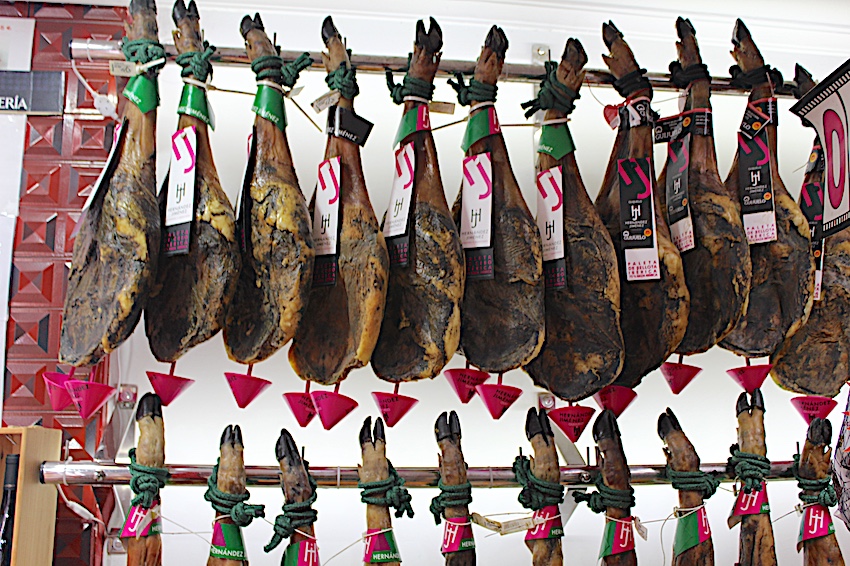
Cured legs of acorn-fed pigs, aka Iberico Ham, hanging in a neighborhood store in Hervás. Photo by Richard Varr
The Cave of Maltravieso features the prehistoric art of Neanderthals hidden within the city of Cáceres, named a UNESCO World Heritage City with its unspoiled medieval-walled Old City. Towns and colorful creekside villages dot plateaus and mountainsides, along with castles perched on hilltops. Original Jewish quarters still exist amidst narrow medieval streets in Hervás, Plasencia and Cáceres. Extremadura is also the birthplace of some of history’s most famous conquistadors and explorers.
Unexplored by many in North America and Asia, Extremadura is roughly the size of Switzerland or twice the size of New Jersey. “The region has always been rural with agriculture and farming as the main economic activities,” points out Marco Mangut, an official tour guide for 25 years. Born in Cáceres, he speaks six languages. “Extremadura has always been cornered on the border with Portugal and away from the main trade routes in Spain.”
“It’s like a small continent in a region with the approximate size of the Netherlands, but with 20 times less population,” points out Cancho who hails from a family of historians and is a co-founder of Guides-Historians of Extremadura. “It’s an authentic place – real people, real food. Almost no one speaks English. It’s safe – no mass immigration, no big cities, no real crime.”
A Roman Outpost
The Emperor Augustus founded Mérida in 25 BC, built to lodge soldiers and veterans stationed in what was Roman Lusitania, a fertile and mineral-rich area that included most of Portugal and western Spain. Why did Rome construct this city in such an isolated province? “The most important goal of the construction of the theaters was to let the Roman colonies know that isolation did not mean abandonment,” explains Cancho. It was also to help the local tribal inhabitants adapt to their new life.

Flooded with spotlights as evening falls, Mérida’s grandiose Temple of Diana houses a Renaissance palace within its fluted Corinthian columns. Photo by Richard Varr
Thus, Mérida was built in the image of Rome with the theater, amphitheater, columned temples, arched gateways and a circus complex. Although much smaller than Rome’s Colosseum, up to 15,000 spectators could fill the rounded amphitheater, that is now partially preserved. The stone blocks of the Arch of Trahan, once a city gateway leading to a colossal temple, today reach up to 50 feet and are flanked by modern buildings with pink and ochre facades.
Bathed in green and purple lights at nightfall, Mérida’s Temple of Diana remains a city centerpiece. Its fluted columns with Corinthian capitals support a decorative upper cornice. It’s a unique ruin of sorts because a Renaissance palace, the Conde de los Corbos house, sits within its frame.
Across from the city’s bullring, roofing protects the ruins of the open-air House of Mithraeum, looking like an archeological dig site. Built at the turn of the 1st and 2nd centuries AD, the house’s several rooms feature well-preserved flooring and, in particular, a mosaic with deity-like figures amidst blue oceans and an earthen background depicting the origin of the Roman universe.
Yet one of the most impressive Roman sites is the stone bridge that stretches for about 2,600 feet over the Guadiana River. “Mérida is not a town with a bridge, it’s a bridge with a town,” quips Cancho. “It was the only bridge in 100 kilometers, so the city had a monopoly on trade in the area.” With 64 arches, it’s the world’s longest surviving Roman bridge, now for pedestrians only.

With 64 arches, the stone pedestrian bridge in Mérida stretches 2,600 feet and is the longest surviving Roman Bridge. Photo by Richard Varr
Another impressive ruin is the Los Milagros Aqueduct, its stone arch supports reminiscent but not as well preserved as the seemingly flawless aqueduct in Segovia. Nighttime spotlights cast a golden glow on the 80-foot-high arches stretching 2,700 feet in a grassy field. Mérida’s world-class National Museum of Roman Art houses mosaics, architectural fragments, household items, and an actual Roman road constructed with a jumble of multicolor slates. Key highlights include a bust of Augustus and the original statue depicting the Goddess of Agriculture Ceres which was once the centerpiece in the Roman Theater.
“Some archaeologists believe her face could resemble Augustus’ wife Livia,” says Cancho. “Mérida was a smaller copy of Rome founded by the special decree of Augustus.”
A small display of chipped Roman-era columns and other antiquities is one highlight of the former 18th-century Baroque monastery now housing the Parador de Mérida, one of Spain’s state-run hotels in restored historic buildings. Locals say the building is haunted by a crying child who once attended school at the monastery. “He loves knocking on the door in the middle of the night,” says guide Laura Corral with Mérida Secreta Evening City Tours.
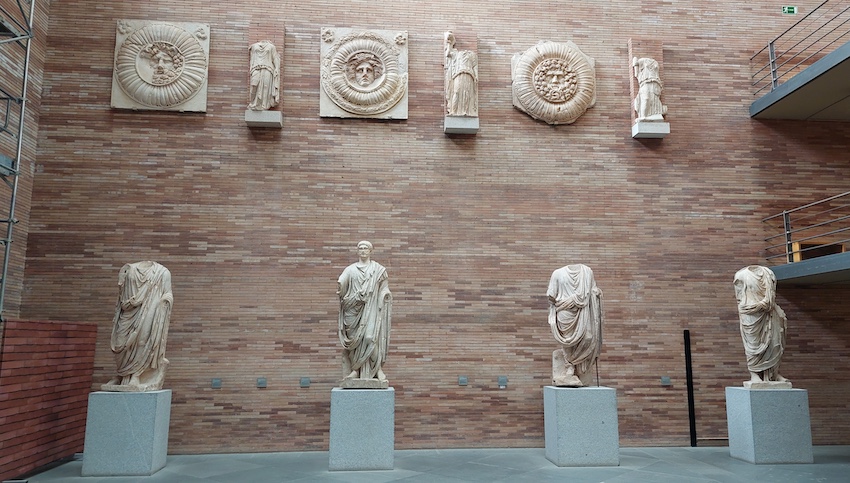
Roman ruins line the walls in Mérida’s world-class National Museum of Roman Art. Photo by Richard Varr
Toga Toga Toga
I’m relaxing in the warm waters of one of the two sky-blue pools of the Alange Spa, about 13 miles southeast of Mérida. The two pools under the domes are the original baths surviving since Roman times and have been declared a UNESCO World Heritage Site. And yes, ancient Romans soaked in these same thermal springs as far back as when emperors Trajan and Hadrian ruled in the 2nd century AD.
“Most probably, according to some partial inscriptions, Emperor Hadrian was here,” says Cancho. “We think there was some kind of Roman establishment in the first or second century AD. We can see some fragments of the original marble decoration.”
I’m sure, however, the Romans didn’t get the pampering I’m experiencing, including being squirted with hot and cold pressure hoses during a so-called “Scottish shower.”
According to the spa’s website, it was maintained through the centuries including when the Moors conquered Mérida in the beginning of the 8th century. In 1863, new renovations included Italian marble baths and adding gardens and pools. Today, the spa offers various therapies and hotel packages.
Another uniquely Roman-like activity has me donning a white garb and leafy vines in my hair – what you might find at a Toga party. I’m sitting for lunch in the restaurant of the Aqua Libera Thermal Spa in nearby Aljucén, a recreated Roman house and hotel with a temple and small pool in the courtyard. The Roman-inspired menu includes spiced olives, lentils with chestnuts, turkey cooked in the Apicius tradition (often with parsley, mint, cilantro and cumin) with dates, semolina and nuts, and squid with date palm and caraway.
Extremadura’s Conquistadors Explore the New World
Another authentic Roman theater sits about 25 miles east of Mérida in Medellin, founded in 79 BC as the Roman colony Metellinum. But what this small town is best known for is the birthplace of one of history’s most fearless conquistadors, Hernán Cortés, who vanquished Mexico’s Aztec Empire in 1521.
“Cortés was like our Spanish Julius Ceasar, conquering a really large portion of an immense continent in less than three years,” says Cancho. Next to the theater, St. Martin’s Church houses the stone font believed used for Cortés’ baptism. A statue of the conquistador with a sword and gripping a flag dominates the central town square.
After attending school in Salamanca, the young Cortés became inspired by the West Indies voyages of Christopher Columbus returning with cargoes of gold and other riches. The search for wealth lured many young men to the New World for two main reasons: Extremadura’s traditional poverty and birth order. “A lot of noble families concentrated much of the family’s heritage only on the first born son. That made other males redundant and willing to leave the region,” explains Cancho. “Their leap to the Americas was the logical thing to do in that situation.”
“For the second sons of noble families, it was a great excuse to escape from going to the church and working as priests or being sent to a monastery as monks,” says Mangut. Some of them became history’s noted New World governors, explorers and conquistadors.
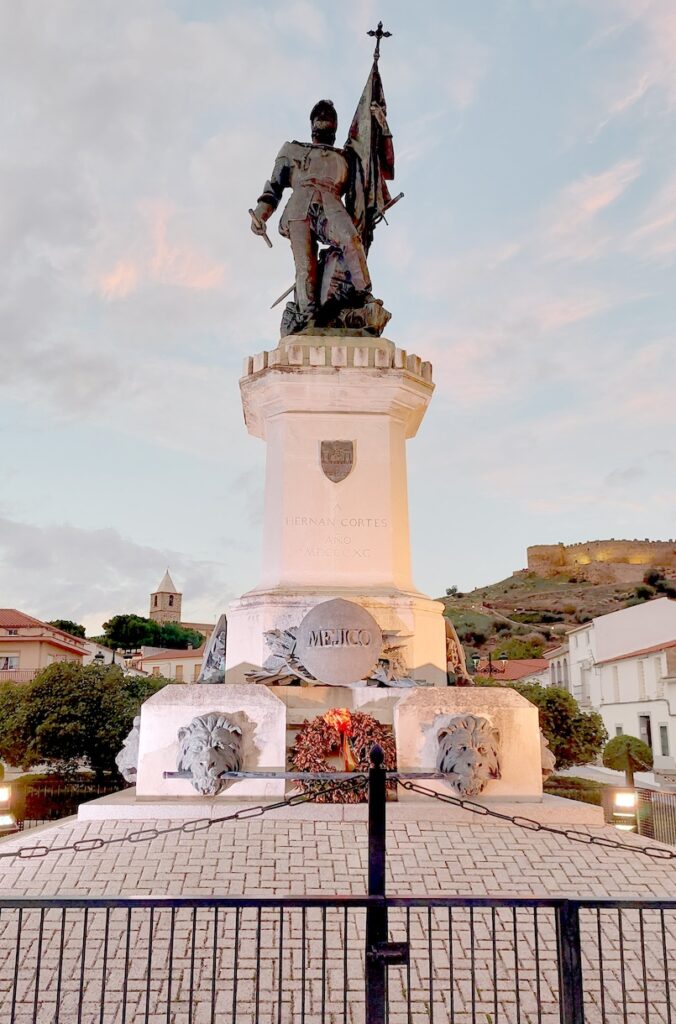
Statue of conquistador Hernán Cortés in Medellin’s town square. Cortez was born in Medellin, and like many young men from Extremadura, was lured to the adventure and quest for gold of the New World. Photo by Richard Varr
A little-known fact is Cortés was a second cousin to the discoverer of Peru and Inca conqueror, Francisco Pizarro from Trujillo, where his birthplace home is now a museum. Pedro de Alvarado was born in Badajoz, Extremadura’s largest city and was Cortés’s second in command during the Aztec conquest and later conquered Guatemala and other areas of Central America.
Extremadura’s vast Royal Monastery of Santa María de Guadalupe with its turreted towers, cloisters and church played an important role in the age of exploration. Within the rolling Villuercas Mountain range, the 14th-century complex was built where purportedly a vision of the Virgin Mary appeared, and it thus became one of the most visited pilgrimage sites in Spain. That’s why Christopher Columbus visited offering prayers of thanks after a harrowing journey back from the New World.
Cáceres: A marvelous medieval town
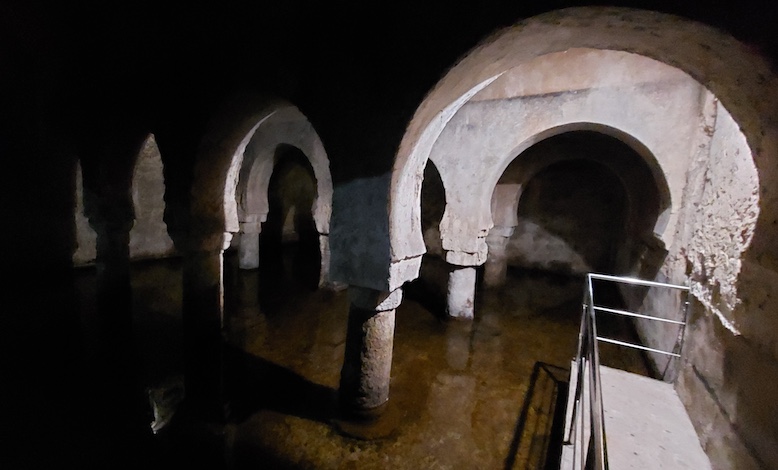
The Cáceres Museum leads to this architectural wonder from the Moors: an underground cistern that can still collect rainwater. Photo by Richard Varr
Strolling along the cobbled streets of Cáceres’ stunningly well-preserved Old City might be as close as one can get to a walk-in medieval Europe. Square and rounded towers, some turreted or with elaborate stone trim, dot the skyline. Distinctive coats of arms with carved images of shields, eagles and even castles hang over doorways and windows, signifying family ownership, heritage and honor. Churches front cobbled squares with their towers casting long shadows at dusk. Narrow streets pass under rounded arches, crisscrossing through what’s like a maze where it’s easy to get lost and confused by similar stone facades.
The houses are a mix of architectural styles through the centuries. The Moors built many of the still-standing towers and sturdy defense walls. Medieval, Renaissance and Baroque palaces followed. Today, the stone mansions, chapels and former monasteries and convents are used as local government offices, restaurants, a tourist information center and pricy residences. Because of its outstanding preservation, the Old City served as a realistic backdrop in Game of Thrones and other productions.
At an entrance of the city walls, the Bujaco Tower is one of the town’s oldest, dating back to the 12 century, with its battlement offering splendid views of the medieval cityscape and Plaza Mayor below. The ivy-covered Sande Tower dates back to the 14th century and its adjacent buildings house Torre de Sande, a Michelin 3-Star restaurant serving traditional stews to eclectic menu choices. Across town, the Cáceres Museum leads to another architectural wonder from the Moors: an underground cistern that can still collect rainwater.
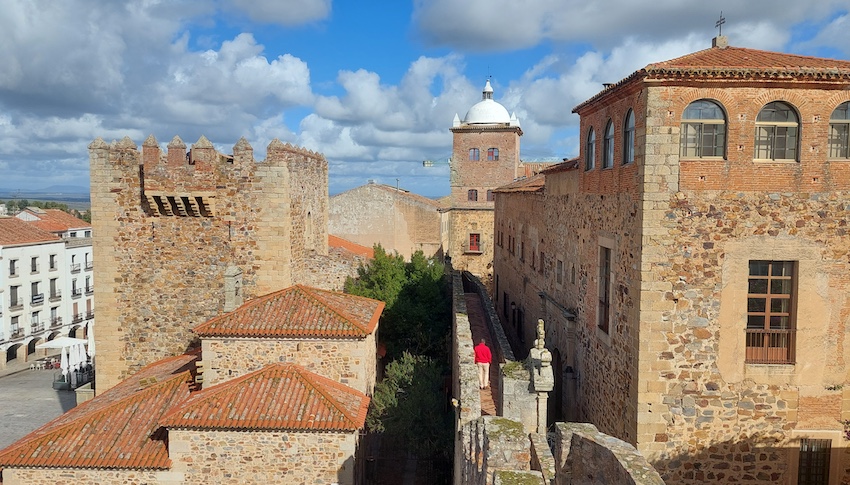
Dating back to the 12 century, the Bujaco Tower was built by the Moors and is one of Cáceres’ oldest towers. Its battlement offers splendid views of the medieval cityscape and Plaza Mayor below. Photo by Richard Varr
When Christians reconquered the city in the 13th century, Cáceres flourished as noble families from New World wealth built their homes and palaces – and quarreled. “They were fighting for territory, power, money and land,” says Mangut. “Nobles fought against each other from tower to tower, house to house and only Queen Isabella could stop all that in 1477.”
What Isabella did, he continues, was set a height limit on city towers, forcing some nobles to demolish the upper stonework. Why? Towers crowned with battlements and turrets were symbols of power and honor. “Having their towers cut off by the queen was a great humiliation. In the end, towers were like phallic symbols for noble people. The bigger it is, the mightier I am.”
Mangut tells that story at the so-called “Palace of the Storks” or Cáceres-Ovando Mansion with its tall tower, the one that Isabella spared. “This is how 30 towers looked in the city before Isabella cut them off, dividing rival factions,” he says, explaining she let this tower stand as a show of gratitude to the owner – the only noble in Cáceres who supported the Catholic Monarchs during the War of Castilian Succession. “He was the privileged man in town, and the others suffered the humiliation of having their towers cut off.”
Another most visited Old City site is the Church of St. Mary, its entrance facing the eponymous square. Gothic pillars separate three naves under a ribbed and vaulted roof. Visitors willing to climb the 100-step stairwell to the top of the Renaissance belfry tower are rewarded with views of the buildings’ red-tinted roofs, a panorama dominated by the Jesuit Church with its dual whitewashed pointed towers.
Mangut tells another tale of how a young girl miraculously escaped death in St. Mary’s during the Spanish Civil War. In 1937, three bombs fell on the square, missing the church but hitting a nearby building. “There was a service on July 23rd. It was 110 degrees and the doors were wide open due to the heat. And that was lethal because shrapnel entered and 30 people were killed in the church that morning at 9:30.”
A couple of minutes earlier, he continues, a 17-year-old girl was delivering newspapers and had run into the church for protection when she heard airplanes overhead. “She thought it would be safe. She was one of the few people in the church whose life was saved because she was short. Everyone in the church who was taller died.”
“She was trapped by dead bodies that saved her life. That 17-year-old girl died eight years ago when she was 95. She was my grandmother.”
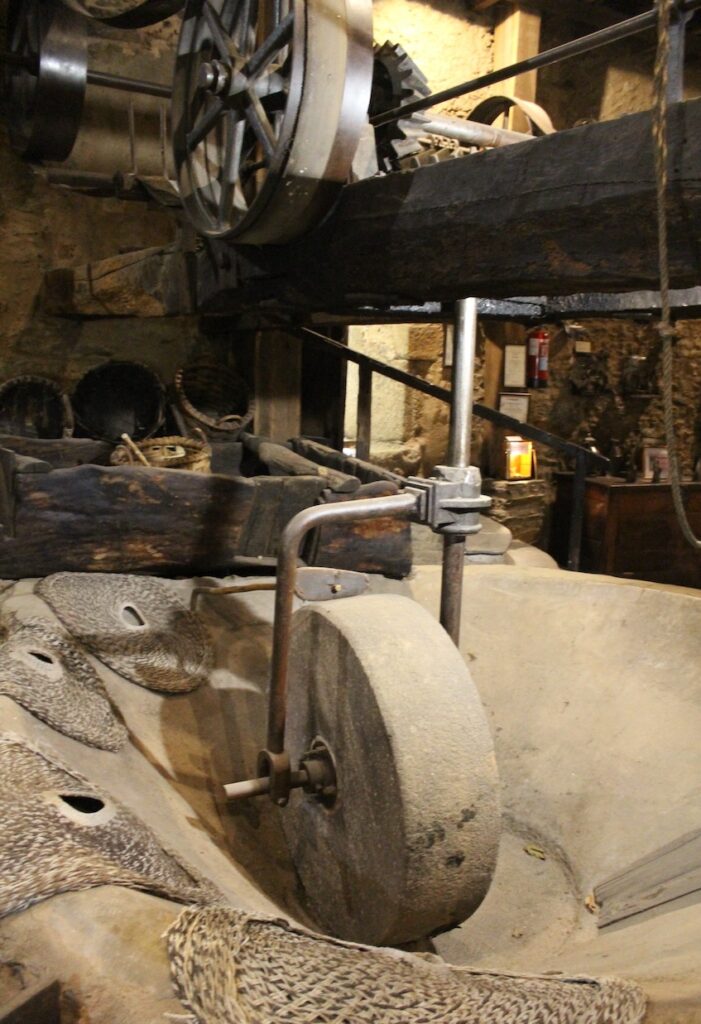
A stone wheel once used for crushing olives is now a centerpiece exhibit in the Molino del Medio museum, which was once an actual olive oil mill. Photo by Richard Varr
Sierra de Gata’s olive oil legacy
Olive groves are seemingly everywhere in the far northern region of Extremadura. They crawl up the mountainsides and snake alongside winding roads, meandering creeks and walking trails. The ancient Phoenicians of the eastern Mediterranean first brought olive trees to the Iberian Peninsula 3,000 years ago, but crops flourished here during Roman times. This area at the foothills of the Sierra de Gata mountains just a short drive from the Portuguese border, the main olive crop is the green Manzanilla Cacereña variety. Here olive farming and oil production is a way of life.
“We use olive oil every day at home, so I like harvesting olives and I do it for the pleasure of it,” says Eduardo Mostazo, a local certified nature and outdoor sports guide for 13 years who also specializes in sustainable tourism. At harvest time, farmers and even small landowners fill crates with green olives, some with yellow and purple-tinted hues, and haul them in for processing. “I take them to a mill and they give me my olive oil. It’s very healthy and fresh and I love the flavor of my own brand,” says Mostazo.
At the As Pontis mill in the small town of Eljas, farmers dump their crates of olives onto a conveyor belt transporting them to presses that crush and separate the oil from the mash. While As Pontis offers this service to local farmers, the mill seasonally produces its brand and varieties of extra virgin olive oil named “Vieiru” using only Mantanilla Cacereñas olives. “Extra virgin means it’s the natural oil of the olive that was just extracted by a mechanical process and nothing else,” explains Ana Isabel Alonzo, Pontis’ Quality Manager.
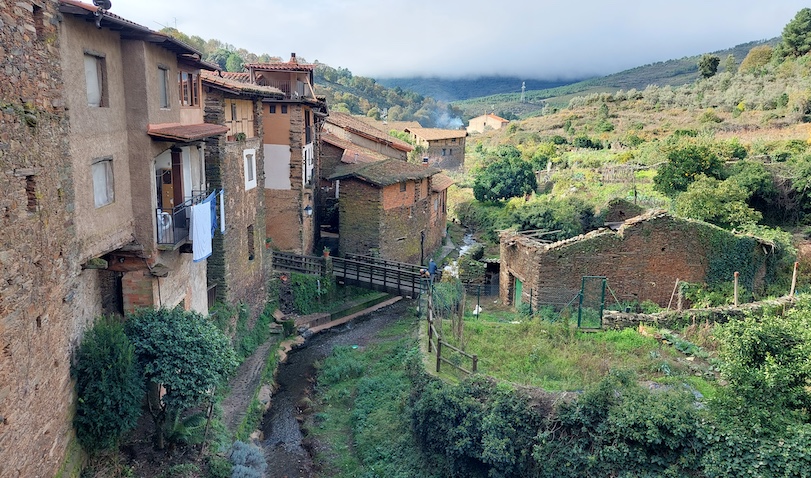
The scenic creekside village of Robledillo de Gata in far northern Extremadura. Photo by Richard Varr
Within Robledillo de Gata, one of the most scenic creekside villages of the region, a stone building that was once an old olive oil factory was restored and is now a museum. Called Molino del Medio, it still houses the olive-crushing stone wheels, belt-driven gears, and oil-collecting tanks. The mill with medieval-era origins, according to the museum’s website, stopped production in 1973. Within rugged stone walls and with an intact water wheel once driven by a nearby stream, the museum showcases how the olive industry was so important to Extremadura and remains that way today.
“I began working in the Pyrenees and came back to Extremadura because of the deep roots of traditions and pace of life, as well as the health of the landscapes,” says Mostazo. “We live within a mix of stones, of geology, of nature and landscapes. But olive groves are everywhere. They are so important for us, for everything.”![]()
A former newspaper and television reporter, Houston-based writer Richard Varr now spends his time searching for enchanting angles of world destinations. Previously, he wrote about Colombia’s coffee culture.

